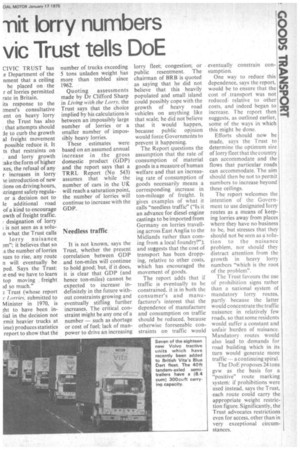nit lorry numbers vic Trust tells DoE
Page 21

If you've noticed an error in this article please click here to report it so we can fix it.
CIVIC TRUST has c Department of the nment that a ceiling be placed on the r of lorries permitted rate in Britain.
its response to the tment's consultative ent on heavy lorry the Trust has also that attempts should le to curb the growth al freight movement possible reduce it. It ts that restraints on . and lorry growth :ake the form of higher xes, the refusal of any ✓ increases in lorry ie introduction of new tions on driving hours, stringent safety regula or a. decision not to le additional road of a kind to encourage owth of freight traffic.
designation of lorry ; is not seen as a solu o what the Trust calls lorry nuisance em"; it believes that so, .s the number of lorries mes to rise, any route n will eventually be ped. Says the Trust: le end we have to learn top moving , freight id so much."
z, Trust (whose report t• Lorries, submitted to Minister in 1970, is ;ht to have been intial in the decision not rmit heavier trucks at ime) produces statistics report to show that the number of trucks exceeding 5 •tons unladen weight has more than trebled since 1962.
Quoting assessments made by Dr Clifford Sharp in Living with the Lorry, the Trust says that the choice implied by his calculations is between an impossibly large number of lorries or a smaller number of impossibly heavy lorries.
These estimates were based on an assumed annual increase in the gross domestic product (GDP) and the report says that a TRRL Report (No 543) assumes that while the number of cars in the UR will reach a saturation point, the number of lorries will continue to increase with the GDP.
Needless traffic
It is not known, says the Trust, whether the present correlation between GDP and ton-miles will continue to hold good; but, if it does, it is clear that GDP (and hence ton-miles) cannot be expected to increase indefinitely in the future without constraints growing and eventually stifling further increases. The critical constraint might be any one of a number — such as shortage or cost of fuel; lack of manpower to drive an increasing lorry fleet; congestion; or public resentment. The chairman of BRB is quoted as saying that he did not believe that this heavily populated and small island could possibly cope with the growth of heavy road vehicles on anything like that scale; he did not believe that it would happen, because public opinion would force Governments to prevent it happening.
The Report questions the assumption that the rate of consumption of material goods is a measure of human welfare and that an increasing rate of consumption of goods necessarily means a corresponding increase in ton-mileage of freight. It gives examples of what it calls "needless traffic" ("Is it an advance for diesel engine castings to be imported from Germany on lorries travelling across East Anglia to the Midlands rather than coming from a local foundry?"); and suggests that the cost of transport has been dropping, relative to other costs, which has encouraged the movement of goods.
The report adds that if traffic is eventually to be constrained, it is in both the consumer's and manufacturer's interest that the dependence of manufacture and consumption on traffic should be reduced, because otherwise foreseeable constraints on traffic would eventually constrain consumption.
One way to reduce this dependence, says the report, would be to ensure that the cost of transport was not reduced. relative to other costs, and indeed began to increase. The report then suggests, as outlined earlier, some of the ways in which this might be done.
Efforts should now be made, says the Trust to determine the optimum size of lorry fleet that the country can accommodate and the flows that particular roads can accommodate. The aim should then be not to permit numbers to increase beyond these ceilings.
The report welcomes the intention of the Government to use designated lorry routes as a means of keeping lorries away from places where they have no business to be, but stresses that they should not he seen as isoluti on to the nuisance problem, nor should they distract attention from the growth in heavy lorry numbers "which is the root of the problem".
The Trust favours the use of prohibition signs rather than a national system of mandatory lorry routes, partly because the latter would concentrate the traffic nuisance in relatively few roads, so that some residents would suffer a constant and unfair burden of nuisance. Mandatory routes would also lead to demands for road building which in its turn would generate more traffic — a continuing spiral.
The DoE proposes 24 tons gvw as the basis for a "positive" route marking system: if prohibitions were used instead, says the Trust, each route could carry the appropriate weight restriction figure. Significantly, the Trust advocates restrictions even for access, other than in very exceptional circumstances.
























































































































